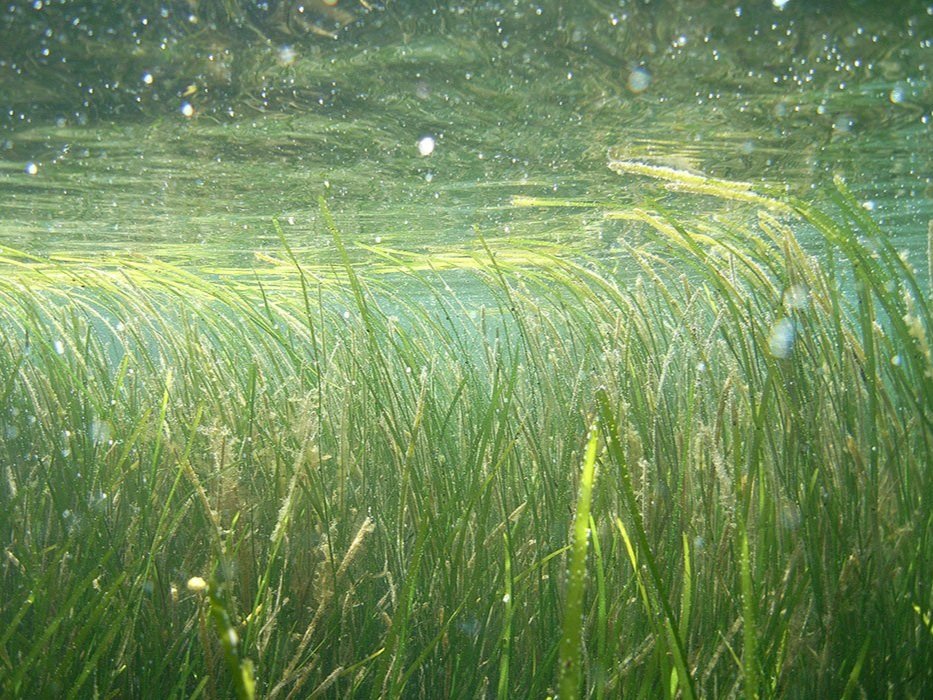Eelgrass Works For You - Swimmers
Not everyone loves the feeling of eelgrass touching them when they go for a swim, but it is important to remember that eelgrass works hard so you can have a safe swim! How is your swim in the waters around Fishers Island improved by eelgrass? Let’s find out!
Clear, unpolluted waters around Fishers Island are brought to you by eelgrass!
Trapping the sediments
It probably does not come as a surprise that sand is denser than seawater - that is why sand sinks! So why does the water ever get cloudy? Water turbulence! Boat motors, currents, tides, storm surges, and waves all cause tiny water tornadoes that create minor disturbances in the water.
In shallow coastal areas, disturbances can lead to cloudy waters from the displaced sediments thrown into the water column. When water turbulence displaces sediments, it takes some time for the sand particles to resettle onto the seafloor. If there are repeated incidents of extreme water turbulence, the sediments will take a long time before they resettle, and they may not settle in the same place leading to erosion. While the particles are suspended, the water is cloudy.
Eelgrass helps to prevent cloudy situations and helps to resettle the sand particles in record time! When the water gets cloudy around Fishers Island, you can count on the dense leaves of the large eelgrass meadows to create barriers and obstacles to a floating particle. As the particle loses speed through repeated encounters with eelgrass leaves, it starts to succumb to its higher density and sink to the seafloor. With denser and more continuous, healthy meadows come faster settling times for the sand particles.
Eelgrass protects the sediments so well by slowing and dispersing the power of the water current, tide, and waves that once these particles settle, they are unlikely to end up in the water column again.
Removing pollutants
If you like to swim around Fishers Island, you may have noticed that there are few water quality hazard warnings. Much of that is thanks to eelgrass! Just as the eelgrass meadows pull the sediments out of the water column and trap them in the seafloor, they also pull pollutants like nitrogen into the seafloor sediments. This process helps the eelgrass utilize nitrogen and prevents it from being used by algae.
Why are algae bad for the water quality around Fishers Island?
Eelgrass is well adapted to competing in the natural marine ecosystem around Fishers Island, but the tables are turned when too much nitrogen is introduced to the system. Algae becomes the dominant vegetation - note: cutting back or removing eelgrass will not eliminate vegetation on your coastline; it will give algae a chance to take over the system instead.
Macroalgae is not a suitable replacement for the ecosystem services that eelgrass provides. An essential part of the eelgrass’s value to Fishers Island is its root and rhizome system that traps and immobilizes sediments. Algae do not have root systems but use a system of holdfasts instead. Holdfasts stick algae to a particular surface, usually a rock or similar, so that they can be easily detached and reattached. This system ensures the algae will survive poor water conditions and intense erosion; however, the coastline must fend for itself. Eelgrass is strong during storms and does its best to battle through muddy or polluted waters to prevent erosion and create clean coastal waters for swimmers.
Furthermore, microalgae can create harmful algal blooms that create toxic conditions that close beaches to any recreation, especially swimming. These blooms are fueled by excess nitrogen in the water introduced by fertilizers applied to lawns and gardens and through septic tanks. The shading caused by the bloom will cause the eelgrass to weaken and die, releasing more nitrogen into the water to fuel more algal blooms in a vicious cycle of scummy water!
Keep in mind during your next swim that eelgrass provides you with these amazingly consistent, clear waters around Fishers Island!


